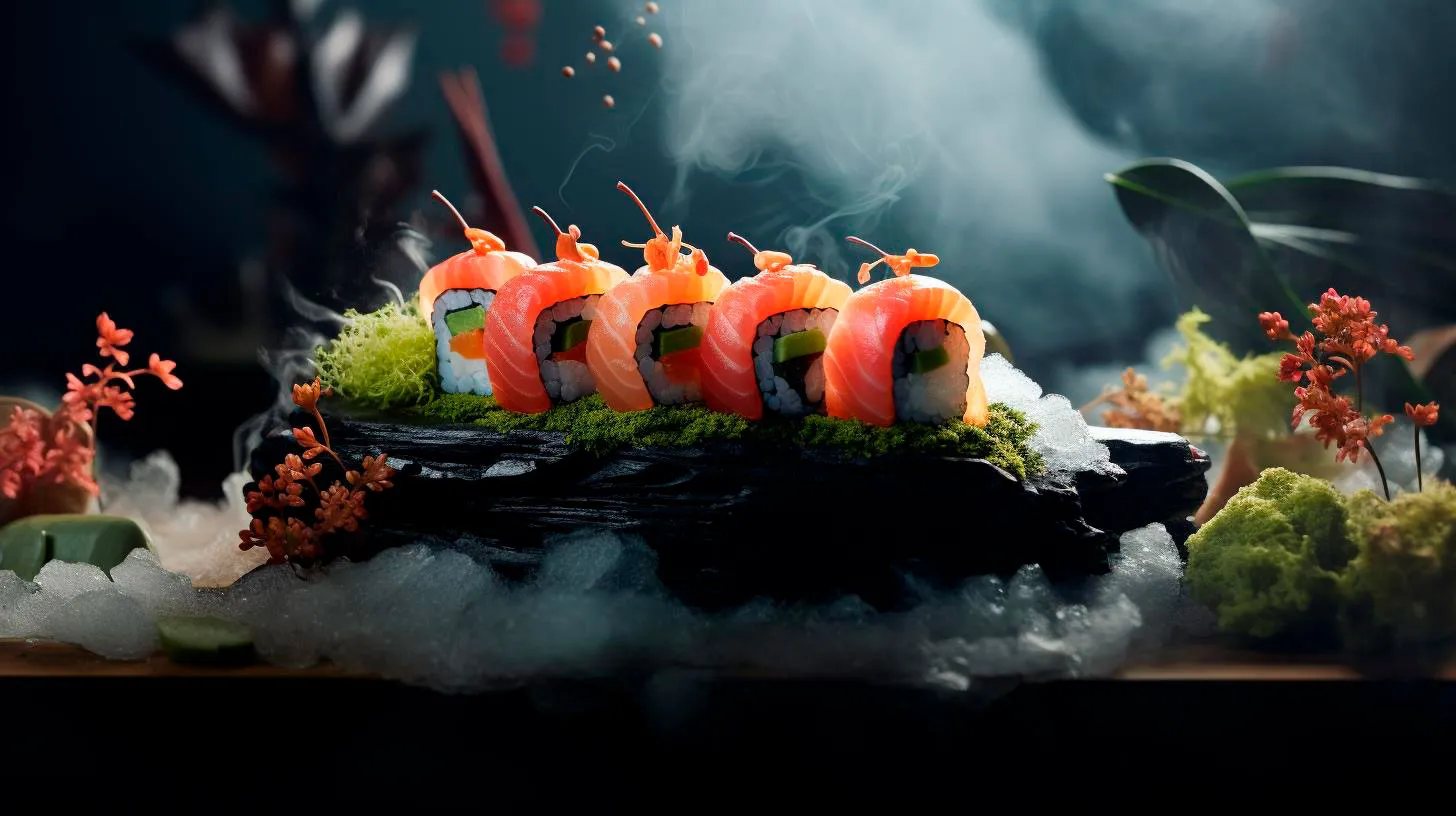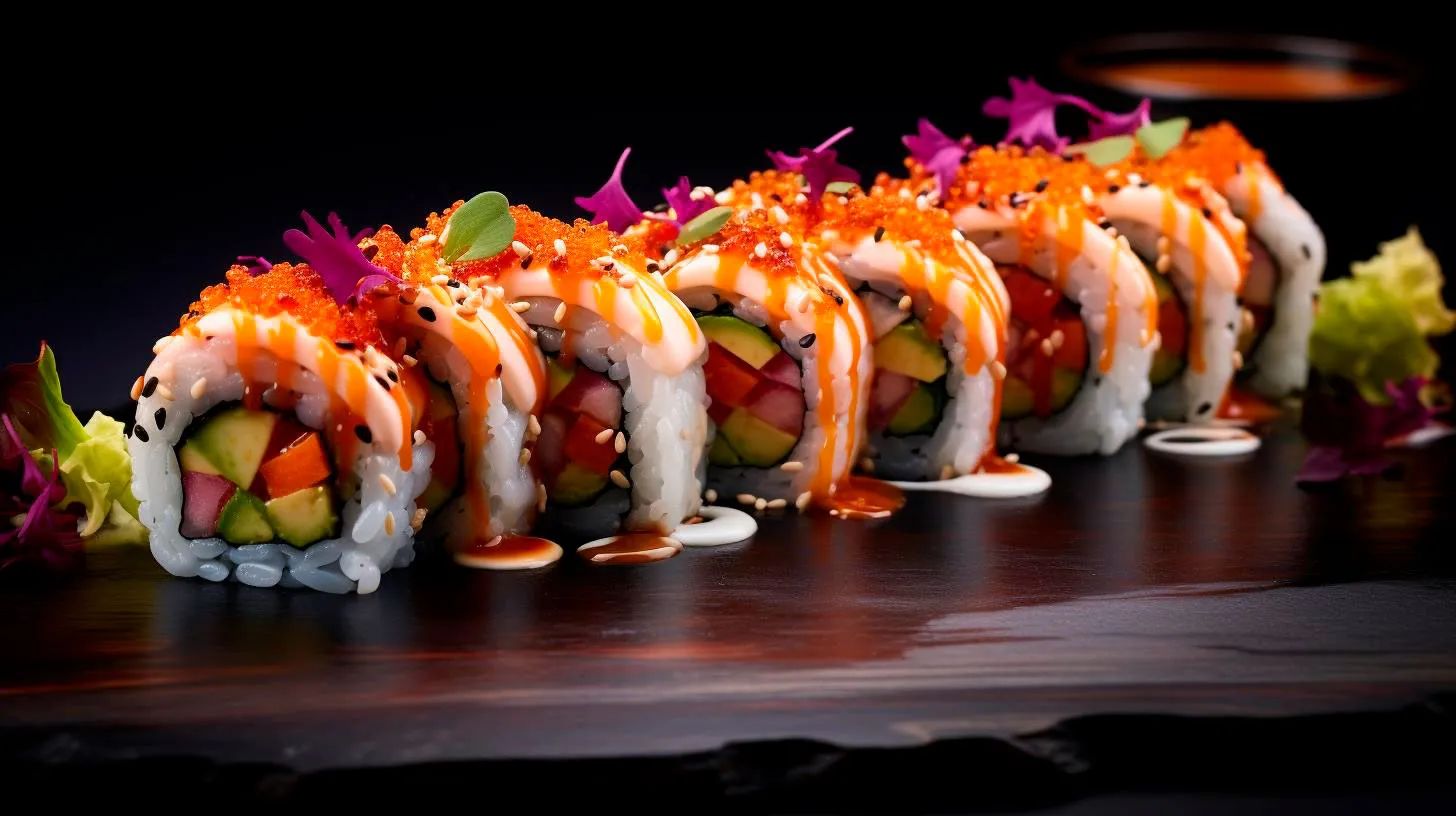The Science of Umami: How Sushi Chefs Master the Art of Balancing Flavors
At the heart of this delectable art form is the concept of umami. In this article, we explore the science behind umami, how sushi chefs master the art of balancing flavors, and why this makes sushi so irresistible.
The Allure of Umami
Sushi is renowned for its diverse and complex flavors. Sushi chefs strive to provide a harmonious balance of tastes, and umami plays a significant role in achieving this. Umami is often referred to as the fifth taste alongside sweet, salty, sour, and bitter. The term umami originates from Japanese and translates to “pleasant savory taste.”
Umami is experienced when certain amino acids, such as glutamate and inosinate, combine with specific receptors on the tongue. This combination creates a unique sensation that enhances the overall flavor profile of a dish. Umami is commonly found in foods like soy sauce, mushrooms, tomatoes, and seaweed, which are all staple ingredients in sushi.
The Science Behind Umami
Umami taste receptors were first discovered in 1908 by Japanese scientist Kikunae Ikeda. He identified glutamate as the key compound responsible for this taste sensation and determined that it could be extracted from the seaweed commonly used in Japanese cuisine. This led to the creation of the flavor enhancer monosodium glutamate (MSG), which is widely used today to enhance savory dishes.
Further scientific research has revealed that umami taste receptors are not only found on the tongue but also in the gut. This suggests that umami plays a role in our overall digestive process. The activation of these receptors triggers the release of saliva and digestive enzymes, which aids in breaking down food more efficiently.
The Art of Balancing Flavors
Sushi chefs undergo years of rigorous training to master the art of flavor balancing. It requires a deep understanding of ingredients, meticulous preparation techniques, and the ability to harmonize tastes. But how do they achieve this?
High-Quality Ingredients:
The foundation of excellent sushi lies in the quality of its ingredients. Fresh fish, carefully sourced, and seasonal vegetables are essential. This ensures maximum flavor and contributes to the overall umami experience.
Skillful Presentation:
Sushi is not just about taste; it is also a visual masterpiece. Chefs meticulously arrange each ingredient to create an aesthetically pleasing dish. The presentation enhances the overall dining experience, making it even more enjoyable.
Perfect Rice:
The rice used in sushi is not just a filler but a crucial element. Sushi rice is seasoned with vinegar, salt, and sugar to provide a delicate balance of flavors. Mastering the texture and taste of the rice is vital to achieving the perfect sushi.
Umami-Boosting Ingredients:
Sushi chefs skillfully incorporate ingredients that enhance the umami experience. Seaweed, soy sauce, wasabi, and pickled ginger are all used to elevate flavors and achieve that sought-after umami taste.
The Irresistible Appeal of Sushi
The meticulous craftsmanship behind sushi and its focus on achieving umami flavors result in an irresistible dining experience. This Japanese cuisine has gained global popularity, and it’s not hard to see why. Here are some key takeaways:
- Sushi achieves a delicate balance of flavors by incorporating umami, the fifth taste.
- Umami is experienced when certain amino acids combine with receptors on the tongue, creating a unique savory sensation.
- Sushi chefs undergo extensive training to master the art of balancing flavors through high-quality ingredients and skillful presentation.
- Umami-boosting ingredients like seaweed and soy sauce play a crucial role in achieving the perfect sushi.
- The overall umami experience enhances digestion and provides a satisfying culinary journey.
Next time you sit down for a sushi meal, take a moment to appreciate the science behind the flavors dancing on your palate. Sushi chefs’ meticulous efforts and the incorporation of umami are what make this traditional Japanese cuisine an unforgettable dining experience.
Going Beyond Soy Sauce: Unforgettable Umami Enhancers for Your Sushi
While soy sauce provides a rich umami flavor, there is a world of other umami enhancers waiting to elevate your sushi experience to new heights. In this article, we’ll introduce you to some incredible umami enhancers that will leave a lasting impression on your taste buds.
1. Ponzu Sauce – The Citrus Infusion
Ponzu sauce is a citrus-based condiment that adds a tangy and refreshing twist to your sushi. Made from a combination of citrus fruits like yuzu or lemon, soy sauce, and vinegar, ponzu creates a harmonious balance of flavors. Its citrus notes cut through the richness of fish and bring out the umami in a delightful way.
- Features:
- Combination of citrus flavors
- Enhances the taste of fish
- Provides a refreshing twist to sushi
- Advantages:
- Creates a unique flavor profile
- Perfect for those seeking a lighter alternative to soy sauce
- Offers a palate-cleansing effect
- Key Takeaway:
Try ponzu sauce for a citrusy burst of flavor that complements your sushi.
2. Wasabi – The Fiery Eruption
If you enjoy a bit of heat, then wasabi is a must-try sushi condiment. Derived from the wasabi plant, this vibrant green paste is known for its pungent, horseradish-like flavor. It adds a fiery kick that intensifies the flavors of your sushi. Be sure to use it sparingly, as it can be quite potent!
- Features:
- Pungent and spicy
- Distinctive green color
- Instantly adds heat to your sushi
- Advantages:
- Enhances the flavors of sushi
- Offers a unique tasting experience
- Provides a burst of heat
- Key Takeaway:
Explore the spicy side of sushi with a touch of wasabi to elevate your dining experience.
3. Pickled Ginger – The Palate Cleanser
When enjoying sushi, it’s common to cleanse your palate between different bites to fully appreciate the flavors. Pickled ginger, also known as “gari,” is the perfect accompaniment for this purpose. Its subtle sweetness and tangy flavor cleanse your taste buds, preparing them for the next sushi sensation.
- Features:
- Subtle sweetness and tanginess
- Distinct pink color
- Refreshing and palate-cleansing
- Advantages:
- Cleanses the palate
- Helps eliminate lingering flavors
- Offers a refreshing contrast to the sushi
- Key Takeaway:
Experience the perfect palate cleanser with a serving of pickled ginger alongside your sushi.
4. Sesame Seeds – The Nutty Crunch
Want to add an appealing crunch to your sushi rolls? Sprinkle some sesame seeds on top! Sesame seeds not only provide a delightful nutty flavor, but they also add a pleasing textural element to your sushi. Whether you opt for black or white sesame seeds, they will bring a new dimension to your sushi experience.
- Features:
- Nutty flavor with a hint of bitterness
- Available in black or white varieties
- Adds crunch and texture
- Advantages:
- Enhances flavor and texture of sushi
- Provides a visual contrast
- Offers an additional source of nutrients
- Key Takeaway:
Give your sushi a delightful crunch by sprinkling sesame seeds on top for a visually appealing and texturally satisfying experience.
The Takeaway
While soy sauce has long been the traditional condiment for sushi, there are several umami enhancers beyond its realm waiting to be discovered. Experience the complexities of flavors by incorporating ponzu sauce, wasabi, pickled ginger, and sesame seeds into your sushi routine.
Next time you have sushi, think beyond soy sauce and explore these unforgettable umami enhancers. From tangy elegance to fiery heat and delicate palate cleansers, these condiments will take your sushi experience to new and exciting heights. Elevate your sushi game and embark on a flavor adventure that will leave you craving more!
The Origins of Umami: Unraveling the Mystery Behind the Fifth Taste
In this article, we will dive into the origins of umami and unravel the mystery behind this fascinating fifth taste.
What is Umami?
Umami, pronounced as “oo-MAH-mee,” is a Japanese term that roughly translates to “pleasant savory taste.” It was officially recognized as the fifth taste in 1908 by a Japanese chemist named Kikunae Ikeda. Umami is often described as a rich, savory, or meaty flavor that can enhance the overall taste of a dish. It adds depth and complexity to various foods, making them more satisfying and enjoyable.
But what exactly causes umami? The answer lies in a specific type of amino acid called glutamate. Glutamate is naturally present in a variety of foods, such as meat, fish, vegetables, and even some dairy products. When consumed, glutamate stimulates certain taste receptors on our tongue, signaling the brain to perceive umami flavor.
The Hidden Power of Umami
Now that we understand the science behind umami, let’s explore its incredible powers in the culinary world. Here are some key takeaways:
- Enhances Flavor: Umami has the ability to enhance the flavors of other taste components, such as sweetness and saltiness, creating a more well-rounded taste experience.
- Boosts Palate Satisfaction: Foods rich in umami can leave you feeling more satisfied and satiated. This can help in portion control and prevent overeating.
- Brings Oomph to Vegetarian Dishes: Umami is especially crucial for vegetarian and vegan diets as it can compensate for the absence of meat-derived flavors.
- Popular Condiments: Many popular condiments, such as soy sauce, Worcestershire sauce, and fish sauce, are rich sources of umami. They are widely used to add depth to various dishes.
Umami in Various Cuisines
The concept of umami may have originated in Japan, but its influence can be found in cuisines all over the world. Here are a few examples:
Japanese Cuisine
Unsurprisingly, umami plays a significant role in Japanese cooking. Dashi, a traditional Japanese stock, is the backbone of umami in many dishes, including miso soup and noodle broths. Other umami-rich ingredients, such as soy sauce and mushrooms, are also frequently used in Japanese cuisine.
Italian Cuisine
In Italy, umami can be found in abundance in dishes like tomato-based pasta sauces, Parmesan cheese, and aged balsamic vinegar. These ingredients contribute a rich and savory flavor, making Italian cuisine so beloved worldwide.
Chinese Cuisine
Chinese cuisine also embraces umami with open arms. Soya bean products like soy sauce, tofu, and black bean paste, along with various seafood and fermented ingredients, add umami depth to a multitude of Chinese dishes.
The Future of Umami
As our understanding of taste and flavor continues to evolve, the role of umami becomes increasingly crucial. The potential uses of umami extend far beyond the culinary world:
- Food Industry: Food manufacturers are actively incorporating umami-rich ingredients into processed and packaged foods to enhance their taste profiles.
- Health and Nutrition: Umami can be a useful tool in promoting a well-balanced diet. By incorporating umami-rich foods, individuals can enjoy flavorful meals while reducing fat, salt, and sugar intake.
In conclusion, the origins of umami may have been unveiled over a century ago, but it continues to captivate taste buds and intrigue scientists today. Understanding the power and versatility of umami opens up a whole new world of culinary possibilities. So, the next time you savor a mouthwatering dish, remember to thank umami for that extra burst of flavor!
Umami Fusion: Discovering the Creative World of Sushi with Unconventional Ingredients
Renowned for its fresh flavors and exquisite presentation, sushi has become a staple in many diets. Today, I want to delve into the realm of umami fusion, where chefs introduce unconventional ingredients to elevate the sushi experience to new heights.
The Art of Umami Fusion Sushi
Traditionally, sushi consists of vinegared rice combined with various ingredients like seafood, vegetables, or even tropical fruits. However, the art of umami fusion sushi welcomes an exciting twist to the traditional preparation. It involves incorporating unconventional ingredients from different cuisines and culinary cultures, creating a harmonious blend of flavors and textures. This delightful fusion not only adds a contemporary touch to sushi but also expands the boundaries of culinary experimentation.
Key Ingredients for Umami Fusion Sushi
1. Truffle Oil: This luxurious ingredient adds a subtle, earthy flavor to sushi rolls, complementing the fresh seafood or vegetables. The distinct aroma of truffle oil elevates the sushi experience, creating a unique and indulgent combination.
2. Mango: Known for its natural sweetness and tropical flair, mango has found its way into umami fusion sushi. The delicate balance of mango’s sweetness and the umami flavors of seafood or tangy sauces creates a tantalizing blend of tastes.
3. Quinoa: Embracing the health-conscious trend, some sushi chefs have replaced traditional rice with nutrient-rich quinoa. This alternative provides a lighter and more diverse base, perfect for those seeking a healthier option without compromising on flavor.
The Advantages of Umami Fusion Sushi
- Exploding Flavors: The addition of unconventional ingredients intensifies the taste and elevates the overall sushi experience.
- Unlimited Creativity: Umami fusion sushi allows chefs to experiment with innovative combinations, creating endless possibilities for unique flavor profiles.
- Appealing to Diverse Palates: By incorporating ingredients from different cuisines, umami fusion sushi caters to a broader range of taste preferences, attracting adventurous food enthusiasts.
Key Takeaways
Umami fusion sushi offers a culinary adventure filled with flavors, textures, and creativity. Here are some key takeaways:
- Umami fusion sushi explores unconventional ingredients, breaking the boundaries of traditional sushi.
- Truffle oil, mango, and quinoa are just a few examples of unique ingredients used in umami fusion sushi.
- The advantages of umami fusion sushi include explosive flavors, unlimited creativity, and appeal to diverse palates.
So, embark on a culinary journey and savor the delicious world of umami fusion sushi. Let your taste buds be amazed by the exquisite combination of traditional and unconventional ingredients, taking sushi to a whole new level!
Sources:
The statistics and ideas presented in this article are solely based on the author’s knowledge and experience in the food industry.



